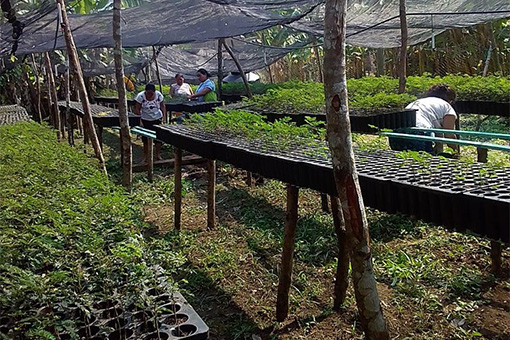Community-level integrated landscape management networks for climate resilience
Organization: Foro para el Desarrollo Sustentable, A.C.
Location: El Palmar, Trembladeras, El Faisan en Centla, Tabasco, Mexico & Las Merceditas, Constitucion Ciutalapa, Francisco I. Madero, Chiapas, Mexico
Country: Mexico
Other Organizations Involved: National Commission of Protected Natural Areas (Conanp); Centla Wetlands Biosphere Reserve; El Ocote Forest Biosphere Reserve; the municipalities of Centla (Tabasco) and Cintalapa (Chiapas); the Palmar, El Faisán and Tembladeras ejidos, in Tabasco, and the Las Merceditas, Francisco I. Madero and Constitución ejidos, in Chiapas; Biodiversity, Environment, Soil and Water (Biodiversidad, Medio Ambiente, Suelo y Agua, A.C.—BioMASA); the Autonomous University of Ciudad del Carmen (Unacar); the Environmental and Civil Protection authorities of the state governments of Chiapas and Tabasco

Background
Located in protected natural areas of two ecological corridors of great importance for conserving biodiversity in tropical regions of southeastern Mexico, many rural and Indigenous communities exist in conditions of high social and environmental vulnerability, given the increased intensity and frequency of extreme climate events, such as forest fires, intense precipitation and winds, floods and droughts in recent years. Furthermore, anthropogenic pressures on ecosystems arising from unsustainable farming and ranching practices (the principal means of local subsistence), in addition to ongoing land conflicts, have provoked habitat loss and fragmentation, erosion and land-use changes, thereby limiting or altering ecosystemic services fundamental to addressing extreme climate events in the region. As a consequence, these factors have generated greater poverty and inequality.
The project proposes to increase the resilience to extreme climate events of six rural communities in the municipalities of Centla (Tabasco) and Cintalapa (Chiapas), Mexico, through the implementation of nature-based solutions and the formation of territorial networks to coordinate local management of climate risk. The idea is to capitalize on local practices and knowledge to promote adaptation, as well as on the community restoration, conservation and integrated management of the landscape, which some groups have already implemented, with elements of ecological restoration, comprehensive fire management, and implementing silvapastoral systems, which translate into greater ecological connectivity, improved environments and living conditions, and the preservation of local knowledge and practices. The model is characterized by a vision of community participation and local governance through community networks and linkages with governmental authorities and is based on providing workshops to build local capacities in relation to climate risk management, extreme events warning systems and disaster prevention.
Goals
- To integrate the six participating local communities in an inter-community system of early warning networks to ensure effective preparations and response to extreme climate events.
- To train 160 community leaders on the implementation of local strategies for preparations, response and adaptation in relation to extreme climate events by means of nature-based solutions.
- To complete and update two plans on climate risk adaptation and management in order to promote their implementation.
- To produce 120,000 plants per year in the municipality of Cintalapa’s community reforestation nursery.
- To implement silvapastoral management practices in 150 hectares in Cintalapa.
- To create and maintain a total of 25 kilometers of firebreak gaps for protection against forest fires in restored/conserved mangrove zones in Centla.
- To restore 30 hectares of mangrove with community participation in Centla, in addition to the 50 hectares currently undergoing restoration.
- To train and equip two community forest fire prevention brigades in Centla.
- To produce five risk identification and analysis factsheets for the same number of nature-based solutions to be implemented as part of the project.
- To document ten relevant local practices, with a focus on nature-based solutions.
- To elaborate 15 communications products for the dissemination of adaptation strategies based on sustainable ecosystems management.
- To motivate one hundred community leaders and ensure their commitment to climate resilience, among those who participate and share in different gatherings and activities to exchange local practices and knowledge.
- To document ten lessons learned from implementing the community networks model of comprehensive landscape management for climate resilience.
Main activities
- Design and implementation of four training workshops on local risk management in relation to extreme climate events, based on nature-based solutions.
- Design and participatory implementation of an intercommunity system of early warning networks to cope with extreme climate events.
- Facilitation of spaces for dialog and cooperation with the municipal authorities to develop agreements to accompany and encourage the implementation of plans on climate risk adaptation and management.
- Maintenance of a community forestry nursery and consolidation of its management.
- Community reforestation of 50 hectares with native forest and forage species, adapted to climate variability.
- Maintenance and, in some cases, creation of a total of 25 km of firebreak gaps for protection against forest fires in restored and/or conserved mangrove zones in Centla.
- Canal cleaning and restoration—with community participation—of 30 hectares of mangrove for flood prevention.
- Delivery of two training workshops on integrated fire management, and equipping community fire brigades with basic protection equipment.
- Application of identification and risk analysis factsheets in the works and actions implemented.
- Documenting at least ten community practices, based on local knowledge, used to promote climate resilience through ecosystems conservation and management.
- Elaboration of social communication materials around the selected practices, using 10 graphic and 5 audiovisual formats. These materials, which must integrate cultural relevance and gender perspective criteria, will target local communities and be disseminated via public community spaces and digital media.
- Two horizontal learning meetings and the exchange of local experiences and practices regarding climate change adaptation.
- At least one participatory workshop to systematize experiences and thereby identify the principal lessons learned and good practices employed during the process.
Results
- Increased community social capital in relation to preparing for, responding to, and adapting to extreme climate events in the region.
- Enhanced ecological connectivity and integrated landscape management via the implementation of silvapastoral systems, strategic ecological restoration and comprehensive fire management.
- Local knowledge and practices are preserved, disseminated and made more effective in the context of climate change.